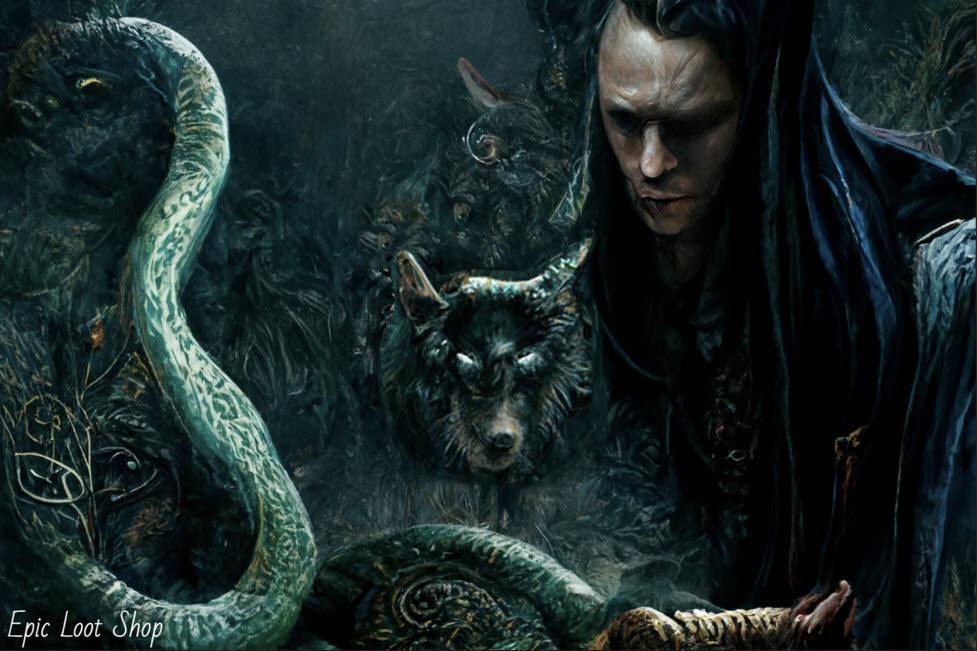Norse mythology is an enthralling and rich tapestry of legends and stories that attract both youngsters and adults. The trickster deity Loki stands out among the many intriguing characters in these myths. His crafty and mischievous disposition landed him into a lot of trouble, but it also helped him produce some of the most terrifying and powerful creatures in Norse mythology - his progeny. In this blog post, we'll look at Loki's offspring, including the enormous wolf Fenrir, the monster snake Jörmungandr, and the half-dead, half-living Hel, and their roles in Norse mythology.
Fenrir, the Great Wolf
One of Loki's most dangerous offspring, Fenrir, was a massive wolf-like beast born from Loki's marriage to the giantess Angrboda. From his birth, the gods of Asgard were distrustful of Fenrir since it was predicted that he would play a vital role in the gods' downfall during the horrific disaster known as Ragnarok.
The gods got increasingly alarmed as Fenrir increased in height and strength. He became so large that he could swallow a whole ship in a single gulp, and his terrifying appearance horrified everyone who came into contact with him. The gods devised several methods to tie Fenrir in an attempt to control him, but he eluded them all. Finally, they enlisted the help of the dwarves, who devised Gleipnir, a magical ribbon as strong as the strongest chain yet as light and silky as silk. Fenrir was fooled by the gods into tying him to Gleipnir, and he was imprisoned on the barren island of Lyngvi.
However, Fenrir's story does not end there. He will break free from his shackles and wreak havoc on the world during Ragnarok, consuming the sun and moon and wrecking disaster. Varr, Odin's son, will slay him to revenge his father's death at the hands of the monstrous wolf.
Jörmungandr, the World Serpent
Jörmungandr, another of Loki's children with Angrboda, is a colossal serpent that encircles the entire planet while grasping its tail in its teeth. Jörmungandr's fate, like Fenrir's, is intertwined with the fate of the gods, and his actions will be essential in Ragnarok's events.
When the gods discovered Jörmungandr's existence, they decided to cast him into the sea to mitigate the threat he posed to them. However, this only increased the serpent's size and power. Jörmungandr grew to the size of the entire world over time, earning him the title of World Serpent.
Hel: the ruler of the Underworld.
Loki and Angrboda's third and final child is Hel, the king of the underworld. In contrast to her siblings, Hel is a half-dead, half-alive entity. Her physique is beautiful and energetic on one side, yet horrible and withering on the other.
When the gods discovered Hel, they made her ruler of Helheim, the land of the dead. This is the land of those who did not die bravely in war, and Hel is in charge of their eternal rest. Despite her role in the afterlife, Hel does not actively seek to afflict or punish the living. She will, however, play a crucial role in Ragnarok's events, leading an army of the dead against the gods, ultimately resulting to their demise.
Conclusion
Fenrir, Jörmungandr, and Hel, Loki's children, play an important role in Norse mythology. Their stories reveal the complex relationships between the gods, giants, and other supernatural beings who inhabit the world of Norse myths. Although these legendary figures are frequently depicted as destructive forces, they also serve as reminders of fate's power and the cyclical nature of life and death. As the realm of Norse mythology continues to captivate new generations, the stories of Loki's children will remain an enduring part of this rich and enchanting tapestry.




Dejar un comentario